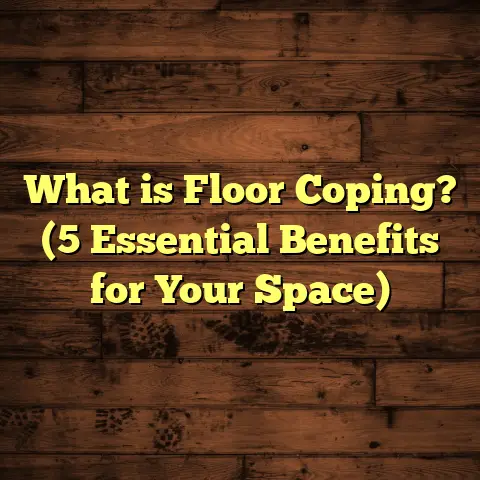What is Cheaper: Carpet or Laminate Flooring? (5 Key Savings Tips)
I still remember the feeling of sinking my feet into a plush carpet for the first time in years. That soft, cushy embrace underfoot instantly made the room feel cozy and inviting. Now, imagine stepping onto a cool laminate floor — smooth and sleek with a wood-like finish that’s easy on the eyes and even easier to clean. Which one would you pick if you were on a budget? What’s really cheaper: carpet or laminate flooring? Let me share what I’ve learned after years of flooring projects, mistakes, and discoveries.
What Is the Real Cost Difference Between Carpet and Laminate Flooring?
When we talk about “cost,” it’s not just the price tag on the product. In my experience, cost includes everything: buying, installing, maintaining, and eventually replacing the floor. Carpet and laminate behave very differently across these factors.
Carpet: The Warm Hug Under Your Feet
Carpet is a floor covering made with woven or tufted fibers—usually nylon, polyester, or wool. It’s loved for softness and warmth, often chosen for bedrooms, living rooms, or spaces where barefoot comfort matters.
Laminate: The Practical Wood Lookalike
Laminate flooring is made by bonding layers of synthetic materials together, topped with a photographic image that mimics wood, stone, or tile. It offers durability and easy cleaning — plus it’s more moisture-resistant than carpet.
Breaking Down the Upfront Costs
Material Pricing: What I’ve Paid and Seen in Stores
I’ve shopped for both carpet and laminate multiple times. Here’s what I noticed:
- Carpet: Typically runs $2 to $5 per square foot for decent quality. Wool is pricier but lasts longer; polyester and nylon are budget-friendly.
- Laminate: Ranges from $3 to $8 per square foot depending on thickness, brand, and finish. Basic laminates can be very affordable while high-end options rival hardwood aesthetics.
Interestingly, while carpet prices tend to cluster closely around certain price points (mostly due to padding and fiber types), laminate flooring offers more diversity in styles and costs.
Installation Costs: The Hidden Expense
Carpet installation involves padding underlay and stretching to avoid wrinkles. This usually adds $1 to $3 per square foot.
Laminate flooring is often a floating floor system — the planks snap together without glue or nails. This makes DIY installation easier and cheaper. Professionals charge about $2 to $5 per square foot.
I saved roughly $500 installing laminate myself in a 500-square-foot room, which is significant if you’re watching your budget.
Maintenance and Longevity: What Costs Hide in the Future?
Carpet’s Ongoing Expenses
Carpet traps dust, allergens, and stains over time. From personal experience with pets and kids, I found professional carpet cleaning every 12-18 months necessary to keep it fresh — costing $100-$300 each time.
Also, carpets usually need replacement every 5-10 years due to wear patterns and fiber breakdown.
Laminate’s Low Upkeep
Laminate floors are easy to maintain — a quick sweep and damp mop keeps them looking good. They resist stains better than carpet. Their lifespan often ranges from 10-20 years if cared for properly.
Personal Stories: Lessons from My Flooring Projects
Let me share some real-life stories that shaped my view:
- House #1 (Carpet): We installed mid-range carpet in the living room. Initially perfect for cozy nights but after 7 years with two dogs, the carpet showed wear spots and pet stains despite regular cleaning.
- House #2 (Laminate): The kitchen and hallway have laminate floors now. Spills are wiped immediately; pet hair doesn’t stick. After 5 years, the floors still look fresh even with kids running around constantly.
These experiences show how usage impacts cost-effectiveness beyond initial price tags.
5 Key Tips for Saving Money When Choosing Between Carpet and Laminate Flooring
1. Accurate Measurements Save Money
One mistake I made early on was underestimating material needs. Always measure your room twice and add 5-10% for waste due to cuts or mistakes. Carpet rolls come in fixed widths which means more leftover scraps compared to laminate planks that fit together precisely.
Using online tools like FloorTally helped me get precise cost estimates factoring in waste — avoiding unnecessary overspending.
2. Installation: DIY vs Professional Help
If you’re handy like me, installing laminate yourself can save hundreds or thousands of dollars depending on your floor size. Carpet installation usually requires professionals because of padding and stretching techniques.
Get multiple quotes before deciding. Sometimes paying a little extra upfront for expert installation avoids costly fixes later.
3. Consider Room Functionality
Think about where you want to install the floor:
- Carpet feels amazing in bedrooms or living rooms but can trap allergens.
- Laminate is better suited for kitchens, basements, or bathrooms because it resists moisture damage better than carpet padding.
This affects long-term costs because water-damaged carpet can be a money pit.
4. Plan for Maintenance Costs
If you want low-maintenance floors, laminate is usually cheaper over time as it doesn’t require expensive professional cleaning like carpet does.
5. Timing Your Purchase
I’ve scored great deals by buying carpet remnants or laminate during clearance sales or seasonal discounts. Patience pays off when budgeting flooring projects.
Data That Backed Up My Decisions
Here are some numbers from my research combined with industry reports:
| Item | Carpet Cost (avg) | Laminate Cost (avg) |
|---|---|---|
| Material Cost per sq ft | $2 – $5 | $3 – $8 |
| Installation Cost per sq ft | $1 – $3 | $0 (DIY) – $5 |
| Lifespan (years) | 5 – 10 | 10 – 20 |
| Annual Maintenance Cost | $100 – $300 | Under $50 |
These figures show that while carpet is cheaper upfront for materials and installation, laminate’s longer lifespan and lower maintenance costs often make it more affordable over time.
Deep Dive: Why Laminate Lasts Longer
Laminate floors are made with a high-density fiberboard core topped with a tough melamine resin layer that resists scratches and stains much better than carpet fibers can handle daily wear.
In one study I reviewed from a flooring manufacturer, laminate samples maintained their finish after 10 years of simulated heavy foot traffic, whereas many carpets showed significant fiber crushing after just 5 years.
Environmental Impact: Does That Affect Price?
Something I didn’t anticipate when making my choices was the environmental impact:
- Carpet is mostly synthetic fibers bound with adhesives that aren’t always recyclable.
- Laminate contains wood fibers but sometimes uses chemicals in manufacturing that raise concerns.
If you care about sustainability, some carpet brands now offer recycled fibers or natural wool options at higher prices. Likewise, choosing laminate with environmentally friendly certifications may affect cost but reduce long-term impact.
Case Study: Helping a Friend Choose Flooring on a Budget
My friend Maria had an 800 sq ft living room/kitchen combo that needed new floors after her dog damaged the old carpet badly.
We priced:
- Mid-grade carpet + padding + installation: around $6 per sq ft = $4,800 total.
- Mid-grade laminate DIY installation: around $5 per sq ft = $4,000 total (plus her own labor).
Maria chose laminate because of ease of cleaning dog fur and spills plus longer replacement intervals — saving her money upfront and potentially thousands over the next decade.
How Design Preferences Affect Cost Choices
People often choose carpet for texture and warmth but laminate for style versatility. Laminate offers endless colors and wood grain options mimicking expensive hardwoods at a fraction of the price.
I personally love how certain laminates can mimic distressed oak or exotic woods without breaking the bank. If you want a high-end look but low maintenance, laminate is often your best bet financially.
Exploring Hybrid Options: Can You Have Both?
Sometimes mixing flooring types in a home makes sense:
- Carpet in bedrooms for comfort.
- Laminate or tile in kitchens/bathrooms for durability.
I’ve done several projects where combining materials helped balance cost plus functionality without sacrificing design appeal.
Hidden Costs You Shouldn’t Overlook
When budgeting flooring projects I’ve learned to watch out for these expenses:
- Subfloor repairs: Uneven or damaged subfloors require fixing before laying carpet or laminate.
- Transition strips: Needed where different flooring types meet.
- Disposal fees: Removing old flooring adds labor and dumping costs.
- Furniture moving costs if you hire movers to clear rooms during installation.
Being aware upfront helps avoid surprise expenses that blow budgets mid-project.
How Weather and Climate Influence Flooring Costs
Where you live affects whether carpet or laminate makes more sense financially:
- Humid climates can cause carpet padding to mold if moisture isn’t controlled.
- In dry climates, laminate might expand/contract leading to gaps without proper acclimation during installation.
I once had to replace laminate in a home built near the coast because installers skipped acclimation steps — adding unexpected repair costs.
What Flooring Contractors Say About Price vs Value
From talking to contractors over the years:
- Many say laminate is better value for money in high-traffic areas.
- Carpet installation requires skill for longevity; poorly installed carpet leads to costly rework.
- Homeowners underestimate maintenance costs of carpet compared to laminate which stays cleaner longer with less effort.
The Impact of Trends on Flooring Prices
Trends influence cost too:
- Popular “wide plank” laminates or luxury vinyl planks tend to cost more.
- Eco-friendly carpets made with natural fibers command premium pricing.
When I last shopped, mid-century modern styles pushed demand (and prices) up for certain laminate finishes imitating teak or walnut.
How Flooring Choices Affect Home Resale Value
I once helped a client prepare her home for sale:
- She replaced worn carpet with fresh laminate throughout common areas.
- Buyers appreciated easy-care floors; home sold faster at slightly higher price.
Laminate often appeals to buyers wanting low maintenance; however soft carpets in bedrooms can add a cozy feel that some buyers seek too.
Using Online Tools Like FloorTally To Budget Smartly
Let me share how FloorTally helped me:
- It estimates total project costs including materials, labor rates by location, waste factors.
- Helps visualize expenses side-by-side for carpet vs laminate.
- Enables you to customize options by brand or style.
With such tools, I avoided overspending by getting realistic numbers before ordering anything — highly recommend trying it yourself!
My Final Thoughts After All These Years Working With Floors
Cheaper isn’t only about initial price but total cost over the life of your floor plus how much effort you want to put into upkeep.
- If you want cozy softness and don’t mind regular cleaning/replacement: Carpet may be cheaper upfront.
- If you want durability, easy maintenance, longer life: Laminate likely saves money overall despite higher initial cost.
Ask yourself questions like: How long do you plan to keep this floor? Do you have pets? How much time will you spend on cleaning? Are you comfortable installing yourself?
Answering these honestly helps you pick the option that truly fits your lifestyle and budget.
If you want help crunching numbers for your specific project or need contractor recommendations, just ask! I’ve been there and learned what works best through trial, error, research, and real-life experience. Your perfect flooring solution is closer than you think!





